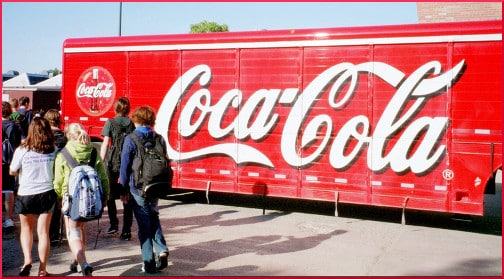
The U.S. government first contributed to the rise of childhood obesity by tinkering with the rules surrounding sugar production and importation, and thus its cost. As explained in great detail by Bartow J. Elmore for Salon.com, the government interfered again by introducing subsidies for agribusiness. These payments (to Big Corn in particular) stimulated the overproduction of corn, leading in turn to the almost universal substitution of high fructose corn syrup for traditional sweeteners.
By 2004, according to the Journal of the American Medical Association, soft drinks containing caloric sweeteners were the “largest single food source of calories in the U.S. Diet.” By 2008, the annual cost in America of treating obesity-associated illness was estimated at an annual $147 billion.
Health consequences and their costs are only two of the evils visited upon humanity by sugar-sweetened beverages, including the industry ringleader, Coke. By 2006, more than 200,000 Coca-Cola product delivery trucks were polluting the world’s air. Soft-drink companies contributed more than their share to the depletion of the planet’s ozone layer, with all the refrigerators and coolers it takes to keep their potions at customer-pleasing chilliness. The nation’s landfills are choked with aluminum and plastic packaging detritus.
Supersizing – The Genius Idea of Coca-Cola
As if all this were not destructive enough, some genius invented “supersizing.” Yes, this atrocity can be attributed to an identifiable individual. Elmore describes the historic moment:
In 1993, a McDonald’s retail strategist named David Wallerstein first introduced the concept of supersizing. The system was exploitative, but few consumers understood the math. Coke found that people would pay a few dimes more for a supersized product, even if that larger serving contained just 2 or 3 cents’ worth of additional sweetener.
Not surprisingly, American diabetes statistics reflected this marketing trend. In the population demographic of 44-year-olds and younger, in only two decades between 1980 and 2000, diabetes doubled. Also unsurprisingly, this disease disproportionately affected members of minority communities and those of low economic status. These groups are also more affected in indirect ways. For instance, poor people and minorities have very little influence over such matters as land use, zoning laws, water rights, and other specifics that determine where huge processing facilities and bottling plants are built.
Soft Drink Companies Benefit From Pollution
The Central Valley of California has much in common with a third-world nation. The agricultural runoff from gigantic farms contaminates the local water supply with arsenic and other undesirable substances, and nobody seems able to keep the food corporations under control or make them accountable for their negative impact on public health.
In fact, the corporations get a two-fer. Because the poor and minority group members who live in these areas are leery of drinking the water, they consume more canned and bottled crap, such as the sugar-sweetened beverages sold by the very companies causing the problems. As the Center for Poverty Research puts it:
Without a reliable, safe source for drinking water—one that both meets contaminant standards and alleviates public perceptions of being unclean—poor families are either stuck with spending more of their limited resources on bottled water or resorting to soda and other unhealthy beverages.
Your responses and feedback are welcome!
Source: “Coke made us all obese: McDonald’s, high-fructose corn-syrup and the sick, super-sized strategy to make you fat,” Salon.com, 01/04/15
Source: “Filthy Drinking Water Is Driving Up Soda Consumption—and Childhood Obesity—in Rural Towns,” TakePart.com, 01/16/15
Image by Zac Zellers

 FAQs and Media Requests:
FAQs and Media Requests: 











